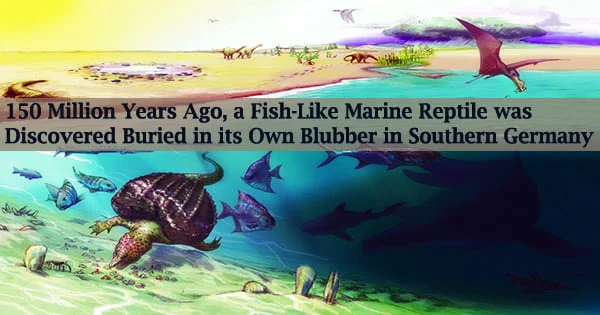Modern technologies are used in a new study published in PeerJ to better understand the preservation of unusual ichthyosaur fossils. In the last, a big group of ichthyosaurs, one entire animal and one tail are the first to retain exterior body shape.
Two ichthyosaur specimens from the Solnhofen area, estimated to be 150 million years old, are described in a new peer-reviewed publication. The Bishops Seminar Eichstätt owns the Jura-Museum, where they are housed.
One ichthyosaur is a full specimen, including the internal skeleton and a soft tissue outline surrounding the body. The other is a fully functional tail fin. It is preserved with the tail vertebrae and soft tissues around it, indicating that ichthyosaurs in this group, like its ancestors, possessed a moon-shaped tail.
A multi-disciplinary team of scientists conducted the research. The principal author, Lene Liebe Delsett, and Jrn Hurum, have worked with marine reptiles at the Natural History Museum in Oslo, Norway, for several years.
Despite their physiological limitations as air breathers, reptiles have frequently colonized maritime settings. Marine reptiles were particularly successful as marine predators during the Mesozoic.
In the past, at the time of dinosaurs and extinct reptiles, marine reptiles were common. Others choose to return to the ocean after making the evolutionary shift to land. Sea turtles, sea snakes, saltwater crocodiles, and marine iguanas are the extant (or presently living) species of marine reptiles.
Martina Kölbl-Ebert is a wildlife expert who specializes in the Solnhofen area. They collaborated with mineralogist Henrik Friis, who studied the soft tissue samples to determine what was present.
“The complete specimen is really what makes this project unique because it tells a complete story. Ichthyosaurs are not common as fossils in Solnhofen, which at the time was a relatively shallow area with many islands, whereas ichthyosaurs were open ocean dwellers. We do not know why this one entered the lagoons, but it might be the reason why it died. Seeing the specimen makes an impact because it is so obviously a complete, dead animal body, where we can see its shape because of the unique preservation,” Delsett says.
The ichthyosaur landed on its back and side on the seafloor during or after death, and was covered in fine particles. It was preserved by a lack of oxygen and a lot of luck until it was discovered and unearthed in 2009.
We know from earlier research that ichthyosaurs likely had a blubber, like whales have today. Our research confirms this, for a group of ichthyosaurs where this has not been certain. The blubber is another strong similarity between whales and ichthyosaurs, in addition to their body shape. In the future, I hope that these two ichthyosaurs from Solnhofen can be used to enhance our understanding of swimming, as they preserve tail and body shape.
Lene Liebe Delsett
In this article, the term “marine” refers to vertebrates that eat virtually exclusively in the sea. This is more stringent than the more typical definition, which includes any vertebrate that spends any amount of time at sea.
The scientists begin the process of understanding the specimen’s soft tissue by describing it in the report. They did this by taking small samples of soft tissue from the tail and examining them with X-ray crystallography and a scanning electron microscope.
UV light was used to study the morphology of the bones to determine which sort of ichthyosaur these are because the skeletons and the rock they are preserved in are nearly the same color. They discovered that phosphate in the ichthyosaurs’ tissues likely contributed to their preservation.
The term “reptile” refers to vertebrates that are commonly referred to as reptiles in English (e.g., “lizards,” snakes, tuataras, crocodiles, and their fossils). In a strict sense, birds are reptiles because they are descendants of some reptiles.
Although all of the ichthyosaur’s petrified tissue types have yet to be identified, the latest study confidently verifies the preservation of skin and probably connective tissue. The majority of the stuff that surrounds and covers the specimen, on the other hand, is most likely decomposing blubber.
“We know from earlier research that ichthyosaurs likely had a blubber, like whales have today. Our research confirms this, for a group of ichthyosaurs where this has not been certain. The blubber is another strong similarity between whales and ichthyosaurs, in addition to their body shape. In the future, I hope that these two ichthyosaurs from Solnhofen can be used to enhance our understanding of swimming, as they preserve tail and body shape,” Delsett says.
Notes:
Ichthyosaurs were marine reptiles that lived during the dinosaur era. Their fossils have been discovered all over the world, and they are known for having a fish-like shape that is similar to that of modern-day dolphins.
The Late Jurassic fossils from the Solnhofen area in southern Germany are famous for including Archaeopteryx, the first bird, and countless other species, many of which were preserved with soft tissues in addition to bones and teeth, which is unusual in the fossil record.
















